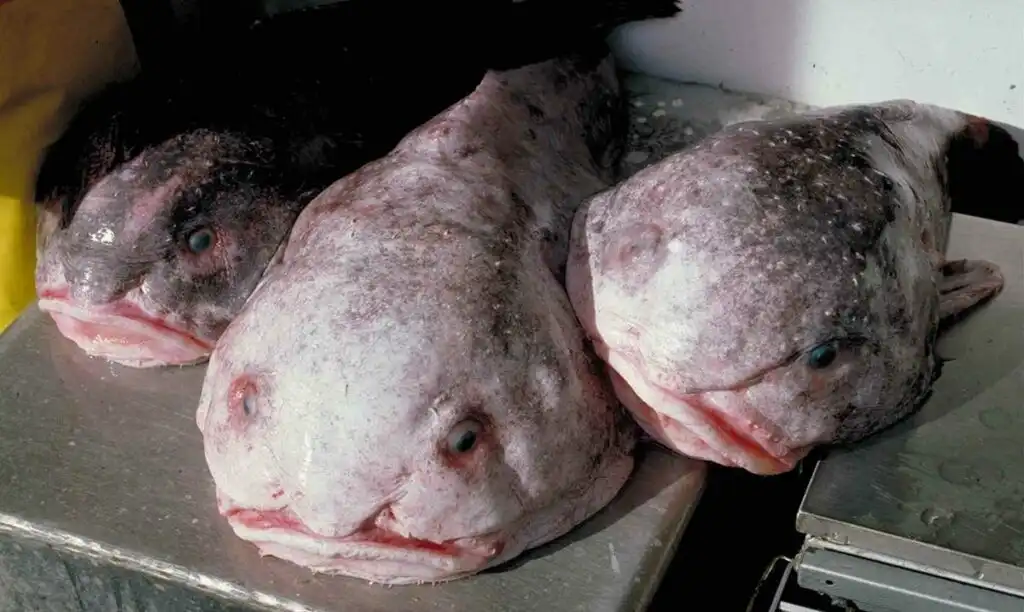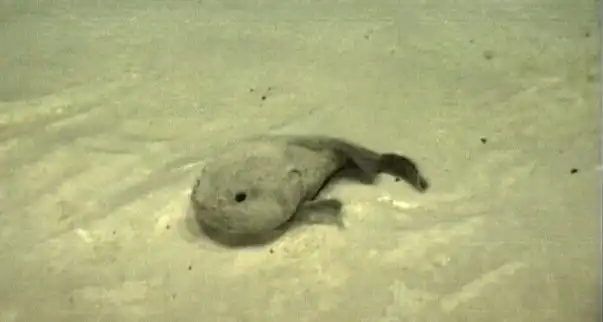Dive into the world of Blobfish, the underwater wonders that often leave us curious and perplexed.
In this journey, we’ll explore simple yet fascinating facts about Blobfish, shedding light on their peculiar characteristics and the mysteries that surround them.
Join us as we unravel the secrets of these unique creatures swimming in the depths of our oceans. Get ready for a splash of knowledge and fun as we present “Facts about Blobfish” in straightforward and easy-to-understand language!
20 Amazing Facts about Blobfish
1. The blobfish was First Discovered in 2003
The blobfish was initially discovered in 2003 and promptly received its now-famous name. Interestingly, ‘Blobfish’ is not just a nickname; it’s the actual, official name of the species.
The inaugural blobfish, discovered during the NORFANZ expedition on the Norfolk Ridge northwest of New Zealand, was affectionately nicknamed ‘Mr. Blobby’ by the scientists and crew who found it. This marked the beginning of the blobfish’s unique identity and its association with the distinctive name it carries today.
2. Blobfish are Native to Oceania
Indigenous to the waters of Oceania, the blobfish is specifically found in the regions off the coasts of Australia and New Zealand. In this aquatic environment, they gracefully navigate the sea floor, adept at capturing unsuspecting small creatures that meander into their path. Thriving at depths averaging 3,000 feet, the surrounding water maintains a temperature just above freezing.
The blobfish has adapted to an extraordinary habitat where the pressure is amplified to a staggering 60 to 120 times greater than the conditions at sea level. Despite the challenging pressure, these unique habitats offer a haven for the blobfish due to their stable temperatures and minimal disturbances, making them an ideal and secure home for this intriguing species.
3. Blobfish Typically Reach a Length of About 12 Inches
Blobfish typically reach a length of about 12 inches. What’s interesting is that they don’t have a swim bladder, which is an air sac that many other fish use to control their buoyancy in the water. Despite missing this feature, blobfish have developed other ways to manage their buoyancy in their underwater habitat.
4. Their Diet Consists of Crustaceans
Have you ever wondered what blobfish like to eat? Well, they enjoy munching on small crustaceans such as crabs, sea urchins, and shellfish. As the blobfish drifts along, it slurps up these tasty treats with its mouth.
Blobfish mainly feast on tiny nuggets—small snail-like mollusks that hang out in the deep sea. These little creatures are slow movers, which makes them easy prey for the blobfish.
Interestingly, blobfish don’t have bones or teeth, and they don’t actively go hunting. Because of their very low muscle mass, they don’t move around much. Apart from eating, their main job is conserving energy.
5. Blobfish are Toothless
If you’ve ever wondered whether blobfish have teeth, the answer is no! Blobfish don’t have any teeth. While encountering a blobfish face to face is highly unlikely because they live in the deep depths of the ocean if you ever did, you wouldn’t have to worry about getting bitten since they lack teeth.
6. Blobfish Have Predators
Blobfish do have predators, and the main threat comes from humans, particularly fishermen. These fishermen unintentionally catch blobfish while fishing in the deep sea. Sadly, this unintended capture is contributing to the decline of the blobfish population, pushing the species closer to extinction.
7. They Have No Conventional Skeleton
The blobfish possesses no conventional skeleton and minimal muscular structure. Its flesh is predominantly a gelatinous mass containing delicate, soft bones. This unique composition enables the blobfish to thrive in high-pressure environments, allowing it to effortlessly float above the sea floor at extreme depths with minimal energy expenditure.
8. Blobfish Don’t Have Bones or Muscles
Blobfish are unique creatures in that they don’t have bones or muscles. Their body is composed of a jelly-like substance, which gives them a normal fish appearance at great depths due to the intense pressure. However, when brought to the surface, they transform into a limp, floppy mass. This physical change is why they are often referred to as “ugly.” The appearance that helps them survive in the deep sea becomes less appealing when they’re out of their natural habitat.
9. Female Blobfish Lay Thousands of Small Pink Eggs
Female blobfish lay thousands of small pink eggs on the seafloor. Interestingly, either the female or the male blobfish takes on the responsibility of sitting on the eggs to protect them from predators. This parental care is crucial for the survival of the blobfish offspring.
10. Their Appearance Change Above the Water

A fascinating aspect of blobfish is how their appearance changes above the water. When they are at their native depth in the ocean, they have a more “normal” appearance. However, when brought to the surface where there is no water pressure to support their shape, they seem to melt into a puddle of goo. This transformation adds to the intrigue and uniqueness of the blobfish.
11. The Blobfish are at Potential Risk of Extinction
The blobfish faces the potential risk of extinction, according to some experts. Due to their habitat in great depths, they are seldom observed, and there is limited knowledge about them. Unfortunately, they are frequently caught unintentionally as bycatch by commercial fishing operations that trawl the ocean bottom.
The significant change in pressure when brought to the surface poses a considerable threat to the blobfish’s survival. This combination of factors raises concerns about the future existence of the blobfish. However, the IUCN has not conducted a study on them, so they don’t currently have an official classification. In truth, we have very limited information about blobfish, and there’s suspicion that they might not be endangered.
Dr. Thom Linley from the Newcastle University research team explained to Fact Animal that assessing their conservation status is challenging due to the scarcity of sightings. Blobfish exemplify the vulnerability of many deep-sea fish, being likely long-lived, slow-growing, and maturing at a late stage.
12. The Blobfish Looks Like a Regular Bony Fish in its Natural Habitat
In its natural deep-sea habitat, the blobfish looks like a regular bony fish, assuming a typical fish-like appearance. The high-pressure conditions in these deep waters provide the necessary support for its gelatinous body mass, maintaining its structural shape.
The exclusive photo below, provided by the Newcastle University research team, was taken 1562 meters north of New Zealand during an expedition led by Dr. Alan Jamieson, a senior lecturer and marine ecology expert specializing in deep and extreme environments.
However, when brought to the surface through methods like bottom trawling nets, the blobfish undergoes a visible transformation. Without the water pressure to uphold their shape, they appear bulbous and gelatinous, leading to the perception of them being less aesthetically appealing.
Dr. Thom Linley from the Newcastle University research team shared insights with Fact Animal, dispelling the myth of the ‘ugly blobfish’ and emphasizing the importance of understanding their appearance in their natural habitat for a more accurate perspective.
13. Voted as the Ugliest Animal
In a 2013 online poll conducted by the Ugly Animal Preservation Society to choose a new mascot, the blobfish received significant attention. With 795 votes out of 3,000, it was overwhelmingly crowned as the world’s ugliest animal, surpassing contenders like the probosci’s monkey, the aquatic scrotum frog, and pubic lice for the top “honour”.
However, it’s important to note that the widely accepted perception of the blobfish as “ugly” is somewhat misleading. Beauty, after all, is subjective, and the title was more of a humorous take on conservation awareness rather than an accurate representation of the blobfish’s true value in the ecosystem.
14. Blobfish Live Under Extreme Pressure Environment
Blobfish inhabit an extreme-pressure environment, experiencing pressures up to 120 times greater than what is found on dry land. To put this in perspective, at such depths, the sheer weight of pressure would crush human organs. The blobfish’s unique adaptation to this intense pressure showcases the remarkable resilience and adaptability of marine life in extreme environments.
15. Blobfish is Closely Related to the Blob Sculpin Species
Blobfish are closely related to the Blob Sculpin species (Psychrolutes phrictus). Capturing images of blobfish on camera has proven to be challenging, and although sightings are still infrequent, the related blob sculpin fish has been more recently recorded on the ocean floor.
Observing the behavior of the blob sculpin provides researchers with valuable insights into how the blobfish likely lives on the sea bed. These related species share similarities, and studying the blob sculpin helps to unravel the mysteries surrounding the habitat and lifestyle of the elusive blobfish.
16. Blobfish Lack a Swim Bladder
Blobfish, unlike most fish, lack a swim bladder. In the deep-sea environment where they reside, having air-filled cavities, which typically aid in buoyancy and movement for other fish, would be impractical.
The immense pressure at their habitat’s depths would cause these cavities to collapse. Instead, blobfish rely on their gelatinous flesh to provide the necessary support, enabling them to navigate and maintain their position in the water without the aid of a swim bladder.
17. Blobfish is Not Considered a Delicacy
Blobfish are not deemed a delicacy, and they rarely end up on dinner plates, unlike many other fish. The primary reason for this is their rarity; blobfish are not as commonly encountered as other fish species.
Additionally, simpler and more readily available fish are often preferred by fishermen, making blobfish an uncommon catch in the fishing industry.
18. Blobfish Don’t Spend Energy Moving Around
Blobfish are energy-efficient creatures that don’t expend much energy on movement. Lacking significant muscles, they don’t actively engage in hunting.
Their jelly-like mass is crucial in this regard, providing them with a density lower than water at the extreme pressures of their deep-sea habitat. This buoyancy allows them to float effortlessly without requiring constant movement, contributing to their overall energy conservation strategy.
19. No One has Ever Documented a Living Blobfish

Documenting a living blobfish has proven to be a significant challenge. The extreme environment in which they reside makes it difficult for humans to properly study them in the wild. Only a few rare underwater photographs of live blobfish have been captured.
The majority of our knowledge about blobfish comes from examining deceased individuals found in trawling nets. The elusive nature of the blobfish and the extreme conditions of its habitat contribute to the limited information available on these unique creatures.
The picture down there might be of a Western Blobfish. It was taken by a special underwater robot (ROV) about 70 kilometers away from Barrow Island on the North West Shelf in Western Australia. The photo was snapped at a depth of around 1220 meters under the sea.
20. Blobfish Live a Long Life
Blobfish live a stress-free life because they don’t have any natural enemies. However, living in the deepest parts of the ocean has its challenges. Blobfish reproduce and grow slowly, but this also means they can live for an impressive 130 years or even more – a long time for a fish!
You may also like:
- 10 Interesting Facts about Dalmatians The Dog
- 11 Interesting Facts About Dogs You Probably Didn’t Know
- 25 Amazing Facts About Axolotls
Wrapping Up
And there you have it – a dive into the intriguing world of Blobfish! We’ve uncovered some cool facts about these gelatinous ocean dwellers, from their unique appearance to the challenges they face in their underwater homes. The Blobfish, with its blob-like charm, continues to surprise and amaze.
Remember, these fascinating creatures teach us that there’s always more beneath the surface – quite literally! As we conclude our journey of exploring “Facts about Blobfish,” let’s keep our curiosity alive and our eyes open for the wonders that the deep-sea world has to offer. Stay tuned for more aquatic adventures, and until then, happy blobfish exploring!



